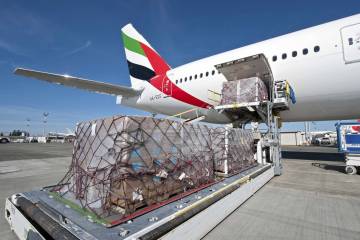Cargo market forecasts from Boeing and the International Air Transport Association (IATA) broadly agree, calling for 2022 revenues in the air cargo market to exceed $200 billion, Boeing director and freighter customer leader Brian Hermesmeyer told AIN in an interview just ahead of the Paris Airshow.
“In 2021, the air cargo industry generated $170 billion in revenue,” he said. “That was significantly higher than 2020 when we were sitting at about $124 billion,” he said. “A lot of that has to do with the high revenue generation that was captured by many carriers in 2021 through the course of the pandemic.”
IATA’s latest monthly report at press time said the rate of decline in cargo tonne-kilometers (CTK) flown slowed appreciably from 17 percent in January to 8 percent in March. “Capacity, as measured in available cargo tonne-kilometers (ACTK) was up 9.9 percent compared to March 2022,” IATA said. “The strong uptick in ACTKs reflects the addition of belly capacity as the passenger side of the business continues to recover.”
Hermesmeyer said the cargo industry has seen headwinds in 2023 compared with the last couple of years. “A lot of that is driven by geopolitical tensions and the drop in consumer spending, although the U.S. tends to be still fairly strong in that regard,” he noted. “The near-term headwinds that we see in 2023 are expected to start to recover by the end of the year into 2024.”
Turning to Boeing’s biannual World Air Cargo Forecast, last published in November, Hermesmeyer said that, globally, he expects cargo traffic to grow about 4.1 percent a year from 2022 to 2041. “GDP will see a 2.6 percent growth rate, trade at 2.8 percent, and industrial production at 2.2 percent,” he added.
As a general rule, while air cargo carries only 1 percent of reported world trade tonnage, it accounts for 35 percent of its value. Freighters play a key role in air cargo: while only 8 percent of commercial jet aircraft are freighters, they carry 54 percent of air cargo traffic.
Hermesmeyer breaks the global air cargo market down into four major subgroups: combination carriers, express carriers, all-cargo carriers, and passenger aircraft bellies.
“Combination carriers have the lion’s share of the revenue generation in the business, with 41 percent, or about $70 billion of revenue in 2021,” he said. “These are carriers that fly main-deck freighters as well as have significant belly capacity in their fleet and leverage both in the way that they move freight.”
Express carriers are well known: FedEx, DHL, UPS, SF Express, as well as China Postal. That segment of the air cargo industry accounts for about $65 billion of revenue or 38 percent of the total.
“Freight airlines operating main-deck freighters are really generating about 90 percent of the revenues in the business, and they play a key role in the major East-West trade lanes, with different percentages depending upon the distances involved,” reported Hermesmeyer.
Belly freight predominates on transatlantic routes, meaning main-deck cargo aircraft carry only around 43 percent of the trade. However, on Europe-Asia and Asia-North America routes, freighters account for 73 percent and 75 percent of the market, respectively, he said.
Hermesmeyer identified three countries in Southeast Asia—Vietnam, Thailand, and Malaysia—that have started to benefit from supply chain diversification. In 2011, Vietnam’s share of Southeast Asia-to-U.S. tonnes was 2 percent, a figure that rose to 7 percent in 2021. “Vietnam is in the early years of becoming an even more relevant provider of goods to the world,” Hermesmeyer said. “They certainly have seen the biggest benefit from the diversification out of China.”
IATA’s March report said that the Middle East’s share of the world’s air cargo market totaled 13 percent, evidence of the strength of performance enjoyed by the cargo operations of Qatar Airways and Emirates.
“The geographic advantage of the region certainly plays into the growth of cargo through the region,” noted Hermesmeyer. “A lot of transit cargo moves through the major hubs in the Middle East, and the carriers that operate in those hubs are combination carriers with large passenger widebody fleets. The combination of the geographic advantage and their global network and reach to aggregate, redirect, and redistribute cargo [benefits them] in ways that other carriers or other regions [do not].”
Hermesmeyer acknowledged Hong Kong’s prime position as the world’s leading airport by cargo volume. According to the International Airport Review, last year the airport handled 4.2 million tonnes of cargo, although the figure represents a decline on 2021 of 16.4 percent.
“Hong Kong remains Hong Kong and you see Cathay Pacific and others operating out of there in a similar fashion,” he said. “I think it’s a combination of geography, but it’s also a combination of the nature of the networks that they have developed that help them move the cargo that they move.”


